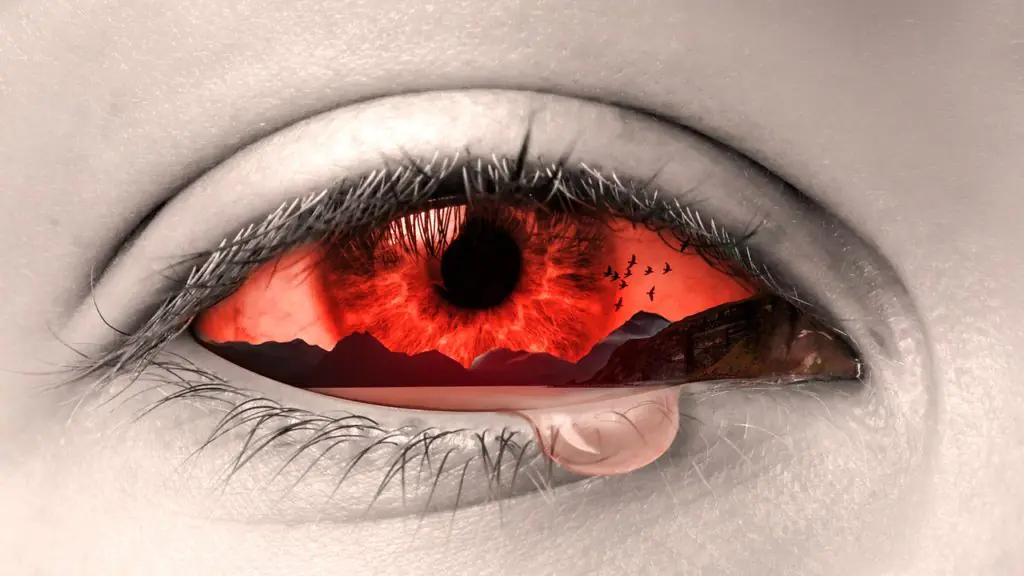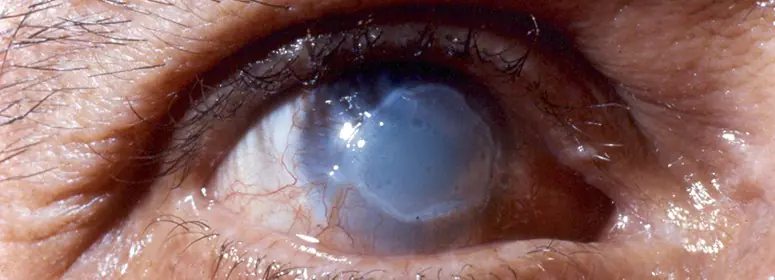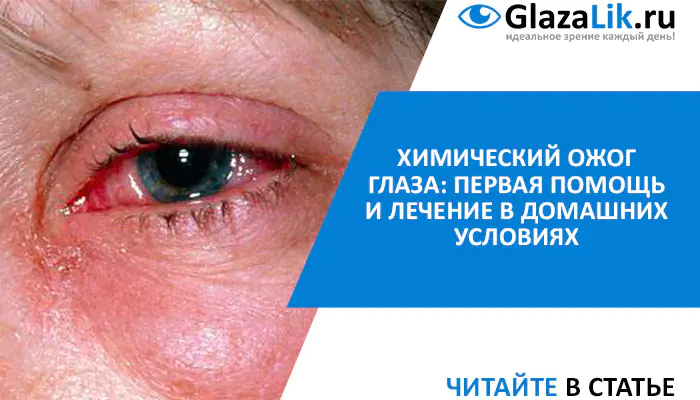Eye burns in most cases occur as a result of work-related injuries. Alkalies, acids and lime are especially dangerous to the eyes. Injury can also occur when particles of steam and molten metal come into direct contact with the organ of vision. When a burn occurs, the skin of the eyelids and conjunctiva are damaged - this leads to ulceration of the cornea and deep structures of the eye
Causes
There are several factors that lead to eye burns:
- Injury occurs due to the ingress of various alkalis and caustic acids.
- Victims receive burns from careless handling of paints and varnishes.
- You should be careful with household aerosols and personal protective equipment.
- Girls should pay attention to the composition of the paint they use to color their eyelashes. They may contain aggressive components.
- Sometimes people mistakenly put solutions intended for treating other organs into their eyes. Such drugs can cause a burn to the cornea.
- Improper handling may cause alkali to get into your eyes. In this case, the victim experiences liquefaction necrosis. This complication leads to cell death. Subsequently, the process of hydrolysis of cell membranes begins. The depth of necrosis depends on the area of contact with the aggressive solution. Information about the severity of the injury can only be obtained 48 hours after the injury.
- The incendiary mixture often leads to eye burns. The reason is the poor quality of the composition, so you should not save money by buying such products.
- Careless handling of fireworks and firecrackers can cause serious harm to people.
Classification of eye burns
Depending on the cause of the injury, there are several types of eye burns:
Eye burns can be divided according to the degree of damage:
- In grade 1, the patient experiences swelling and superficial erosion of the cornea. With appropriate treatment, these lesions disappear without a trace.
- A sign of degree 2 is damage to the skin of the eyelids. After injury, swelling and shallow necrosis occurs. The burn causes damage to the epithelium and stroma of the cornea. There is a change in the appearance of the surface of the cornea. It becomes grayish-cloudy. Burn blisters can be seen on the skin of the patient's eyelids.
- 3rd degree burns can lead to serious consequences. The victim experiences necrosis, and the tissue of the eyelids, cartilage and sclera is damaged. The conjunctiva becomes yellowish, the cornea becomes cloudy, and moisture disappears on its surface. The injury may be complicated by the development of cataracts and iridocyclitis. After the scab is rejected, scar formation begins, which can affect more than 50% of the surface of the eyeball.
- A distinctive feature of grade 4 is deep tissue necrosis. After the injury, areas where charring of the conjunctiva of the sclera of the diseased eye has occurred are identified. Damage to the cornea leads to... that it becomes like a white porcelain plate. The victim suffers from cataracts or glaucoma. In particularly severe cases, corneal perforation occurs.
Symptoms of an eye burn
A sign of mild damage is sharp pain in the affected eye. The conjunctiva turns red and moderate swelling of the tissue appears. A person experiences a sensation of a foreign body in the eye and vision is impaired. When steam particles enter the eyes, a reflex closure of the palpebral fissure occurs. Thanks to the protective reaction, only the eyelashes are affected.
A thermal burn causes eyelashes to burn. In the future, this can lead to trichiasis. This disease is accompanied by abnormal eyelash growth. In the case of a severe burn, necrosis begins in a person and the sclera becomes exposed.
The injury is accompanied by the formation of ulcers on the surface of the cornea. Scarring occurs on the burned cornea. Patients with corneal burns complain of constant lacrimation and photophobia.
After an injury, the victim’s cornea becomes cloudy and neurotrophic keratitis begins. The lesion has a negative impact on a person’s visual functions. The victim may completely lose vision and become disabled.
Why do people get burns to their eyes from welding? The cause of this injury is the effect of UV rays on the conjunctiva of the eye - the inflammatory process begins, and the integrity of the cell membrane is disrupted.
The patient begins to experience severe pain. Lack of timely treatment can lead to complete loss of vision. Symptoms of an eye burn from welding include discomfort in the affected area. The person suffers from pain, he develops photophobia and profuse lacrimation.
Diagnosis of eye burns
The doctor examines the affected areas of the eyes. Eyelid lifters are used to perform an external examination of the affected eye. A person's visual acuity must be determined. To assess the patient's condition, intraocular pressure is also measured.
The victim is sent for ophthalmoscopy and biomicroscopy. During the procedure, areas with flaws and defects in the cornea are identified. Based on the results obtained, the doctor prescribes treatment.
First aid rules
First aid should be provided taking into account the cause of the damage. In case of a chemical burn, it is necessary to urgently remove aggressive reagents from the eye. To do this, you can use sterile cotton wool. After removing the chemical, the eyes should be rinsed with clean water.
Take a piece of sterile cotton wool and soak it in water without squeezing. Rinsing should begin from the temples towards the nose. The duration of rinsing is 15 minutes. If alkali gets in contact, the victim should rinse their eyes with a 2% boric acid solution. If acid gets into your eye, you need to rinse it in an alkaline environment. To do this, you can use a baking soda solution.
What to do if the victim has a thermal burn? Help for such people is to wash the eyes. During the washing process it is necessary to get rid of the damaging substance. Please note that the temperature of the liquid should not be more than 18 degrees. After rinsing, an analgesic is instilled into the eyes. It is necessary to prevent the development of the inflammatory process.
Some patients suffer burns from welding. The injury is accompanied by severe pain. To relieve pain, the victim can be given a tablet of any painkiller. An infection that gets into the eye can complicate treatment, so after rinsing the eye, drops with an anti-inflammatory effect must be instilled.
Treatment of eye burns
First of all, you need to rinse the sore eye with running water. Experts do not recommend using neutralizing solutions yourself, as they can lead to an allergic reaction.
After the burn, foreign bodies are removed from the surface of the conjunctiva and cornea. It must be washed with an anesthetic effect. To prevent the development of an infectious disease, the victim must be administered anti-tetanus serum.
Doctors prescribe cytoplegic agents (atropine, scopolamine) to be installed into the eye of patients. These drugs reduce pain and reduce the risk of adhesions. To avoid infections, it is necessary to use eye ointments and drops with an antibacterial effect. These include Tetracycline and Levomycetin.
Patients with eye burns often suffer from dry corneas. Such victims can be helped by using tear fluid substitutes. The patient is given intramuscular injections of antioxidants. The drugs help accelerate corneal regeneration.
To restore the cornea, it is necessary to apply eye gels. Many people suffer from increased intraocular pressure after their injuries. To help such patients, doctors recommend the use of local antihypertensive drugs (Betaxopol, Dorzolamide).
You can cope with a sunburn by applying a cold compress to the sore spot. Low temperature can reduce pain and prevent swelling.
Glucocorticoids are used for severe eye injuries (Dexamethasone, Betamethasone). During the rehabilitation period, the patient is recommended to undergo physical therapy procedures. The method of surgical intervention depends on the nature and extent of eye damage.
If acid or alkali gets into the anterior chamber of the eye, it becomes necessary to perform corneal paracentesis. During the operation, dead tissue is removed. If deeply affected by aggressive liquids, the patient risks permanent loss of vision.
The victim needs urgent surgery. Surgical methods are used to remove scar formations on the cornea. Only surgery can help a patient suffering from trichosis.
Prognosis and prevention
The results of treatment depend on the severity of the injury and the correctness of drug therapy. After a severe eye burn, the patient develops a cataract and the visual functions of the eye are impaired. When examining patients, atrophy of the eyeball can be detected.
According to experts, about 90% of accidents can be avoided. To do this, you need to comply with safety requirements when handling chemicals. You should not buy flammable liquids for barbecue or firecrackers. Be sure to use safety glasses when working with household chemicals.
About corneal burns, causes and treatment - in the video:
Varieties
A chemical burn of the eyes is one of the types of injuries to the organs of vision that occurs as a result of contact with the mucous membrane of aggressive chemicals in liquid, solid or vapor form. The substances listed below can act as a chemical agent.
Alkalis
They pose a serious danger to the organs of vision, affecting the deep-lying structures of the eye. The higher the pH level, the more severe the injury will be. Most often, alkali damage results from exposure to the following agents:
Acids
When the eyes are exposed to acidic agents, only the external structures are affected, so the consequences are less dangerous. However, such injuries severely damage the cornea, causing decreased vision. Chemical burns to the organs of vision can be caused by the following acids:
Chemical burns to the eyes can be of an industrial or household nature.

Symptoms

A chemical burn to the eye manifests itself with a clear clinical picture that cannot be ignored. When the conjunctiva is damaged by chemicals, severe pain occurs and the following symptoms are observed:
- burning, cutting;
- tearfulness;
- photophobia;
- swelling, hyperemia of the eyelids;
- swelling of the cornea;
- redness of the eyeball;
- blurred vision.
Damage to the organs of vision by alkali or acid causes a feeling of severe discomfort, a feeling of a foreign object or sand in the eyeball, due to which the patient cannot open his eyes normally. Often there is a decrease in the quality of vision. The clinical picture may vary depending on the severity of the injury:
- Mild degree. There is hyperemia of the eyelids and conjunctiva, swelling of the epithelium and sometimes erosion of the cornea. The prognosis is favorable, healing is rapid
- Average degree. Accompanied by swelling and hyperemia of the eyelids and conjunctiva, superficial clouding of the cornea and small blisters.
- Difficult stage. It is characterized by necrotic changes in the skin of the eyelids and conjunctiva, the cornea becomes cloudy, and the conjunctiva becomes covered with a scab. Most of the eye is affected and is often combined with cataracts and iridocyclitis.
- Particularly difficult stage. All tissues of the eyeball are affected, deep necrosis and charring of the sclera are observed. Perforation of the cornea, secondary glaucoma, and uveitis often occur.
Often, a chemical burn is accompanied by damage to the skin, on the surface of which multiple small blisters form.
Possible consequences

A chemical burn to the eye is a serious injury that can cause blindness. The consequences of exposure to chemicals on the organs of vision can be very diverse and largely depend on the type of aggressive agent. An acid burn leads to severe pain that can provoke a painful shock, but with timely assistance there are no negative consequences. The most dangerous are alkaline injuries, as they change the structure of the eye and provoke tissue death, increasing ophthalmotonus.
Regardless of the type of aggressive substance, the following primary complications may occur as a result of injury:
- swelling of the cornea;
- conjunctivitis;
- perforation of the cornea;
- cataract;
- inflammatory processes;
- acute increase in ophthalmotonus.
A few days or weeks after a chemical burn, the following negative consequences may appear:
- secondary cataract or glaucoma;
- scarring of the conjunctiva;
- ulceration or vascularization of the cornea;
- phthisis.
With a chemical burn, visual acuity decreases and vision loss is possible.

First aid
First aid should be provided immediately after the accident occurs. Immediately after the incident, it is necessary to carry out the following PMP algorithm for chemical eye burns:
- Rinse your eyes well with saline solution or plain clean water. It is recommended to do rinsing not under running water, but to fill a container with warm water, lower your face into it and blink vigorously. This action should be performed for at least 20 minutes.
- In case of a chemical burn with acid, it is recommended to use a soda solution or potassium permanganate for washing.
- The effect of an alkaline agent can be neutralized with a 2% acetic acid solution.
- If there are foreign particles in the eye, they must be carefully removed.
- To eliminate pain, you should take a painkiller.
After this, you need to apply a sterile bandage to the sore eye and send the victim to the doctor. In order for the ophthalmologist to select the most effective treatment, it is recommended to take with you a bottle of the damaging substance.
Drug treatment
What to do if your eyes are burned by chemicals? After first aid has been provided, it is necessary to contact an ophthalmologist, even if the condition has improved significantly. After a thorough diagnosis, the doctor will assess the severity of the injury and select the appropriate treatment. For chemical burns to the eyes, the following medications may be prescribed:
- antibiotics: Tsipromed, Floxal;
- disinfectant drops: Levomycetin, Sofradex;
- corticosteroids: Betamethasone, Maxitrol;
- analgesics: Alcaine, Inocaine;
- anti-inflammatory drugs: Indocollir, Dexamethasone;
- mydriatics: Cyclomed, Irifrin;
- corneoprotectors: Korneregel, Solcoseryl gel.

Treating a burn at home
How to treat eye burn injury at home? Treatment at home for eye burns is impossible. Rinsing the organs of vision with various herbal decoctions or tea leaves will not bring a positive result, so you need to seek qualified medical help as soon as possible. In case of a chemical burn at home, as a last resort, you can wash your eyes with a weak manganese solution.
What not to do?
In case of chemical burns to the eyes, first aid should be provided to the victim as quickly as possible, and then contact an ophthalmologist. You cannot delay in providing pre-medical care, as the consequences of this can be extremely serious. In case of such an injury, it is strictly prohibited:
- rub your eyes;
- puncture blisters;
- use eye drops for chemical burns;
- apply healing agents without washing the eyes;
- treat damage with alcohol.

Prevention
Chemical burns to the eye are most often of an industrial nature, so the main measure to prevent such a serious injury is compliance with safety precautions. When working with chemicals, be sure to wear safety glasses. At home, it is also necessary to protect your eyes when using hazardous chemicals and always study the instructions and composition in detail before you start using an aggressive product. If there are small children in the house, then all household chemicals should be stored out of their reach.
">



